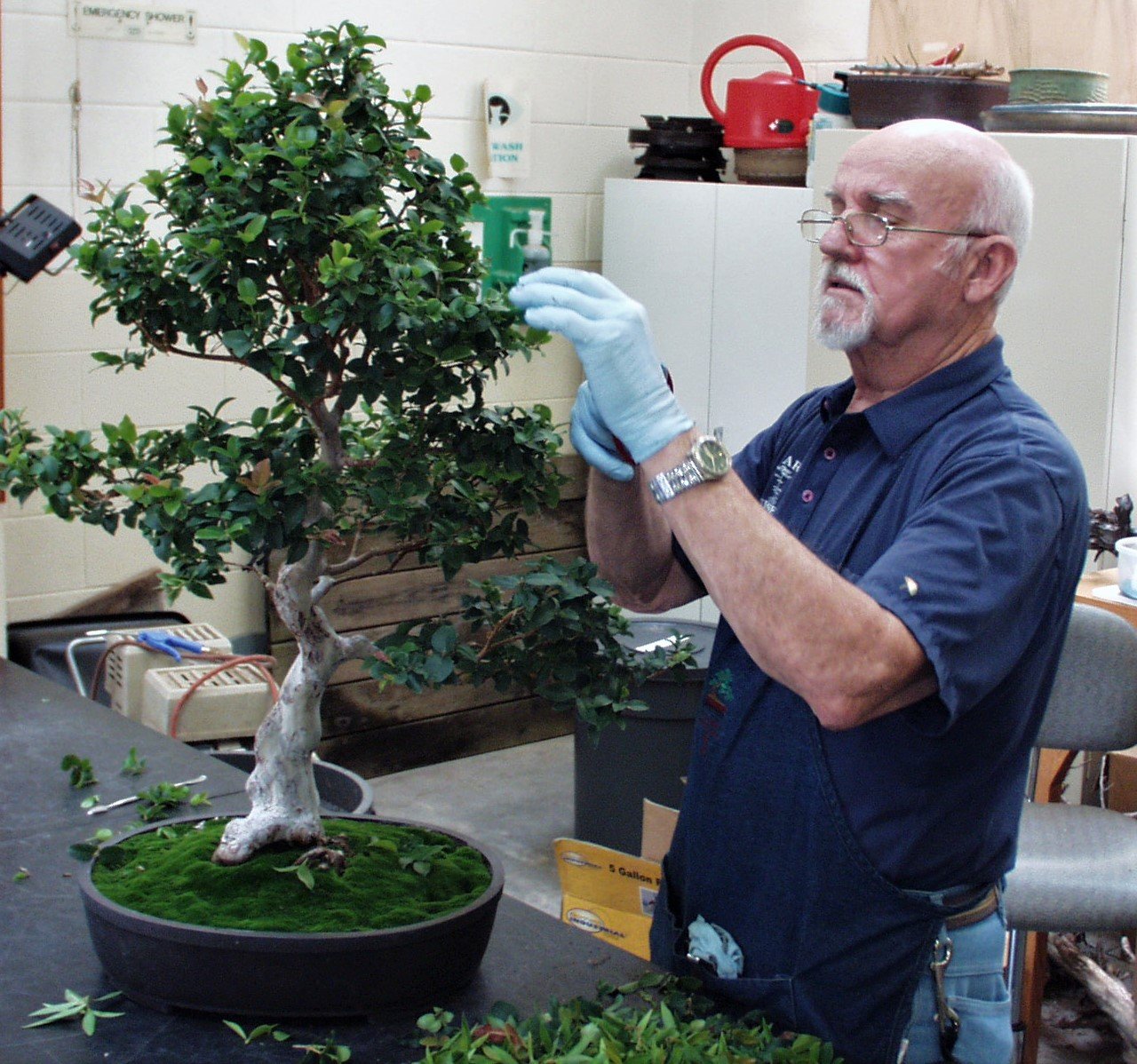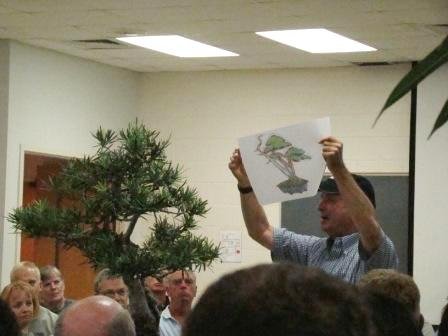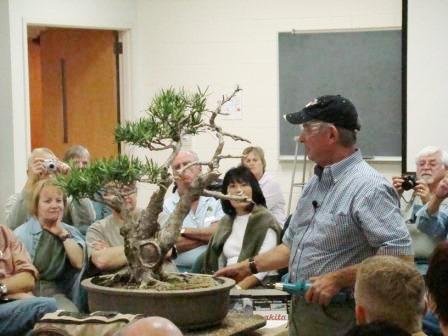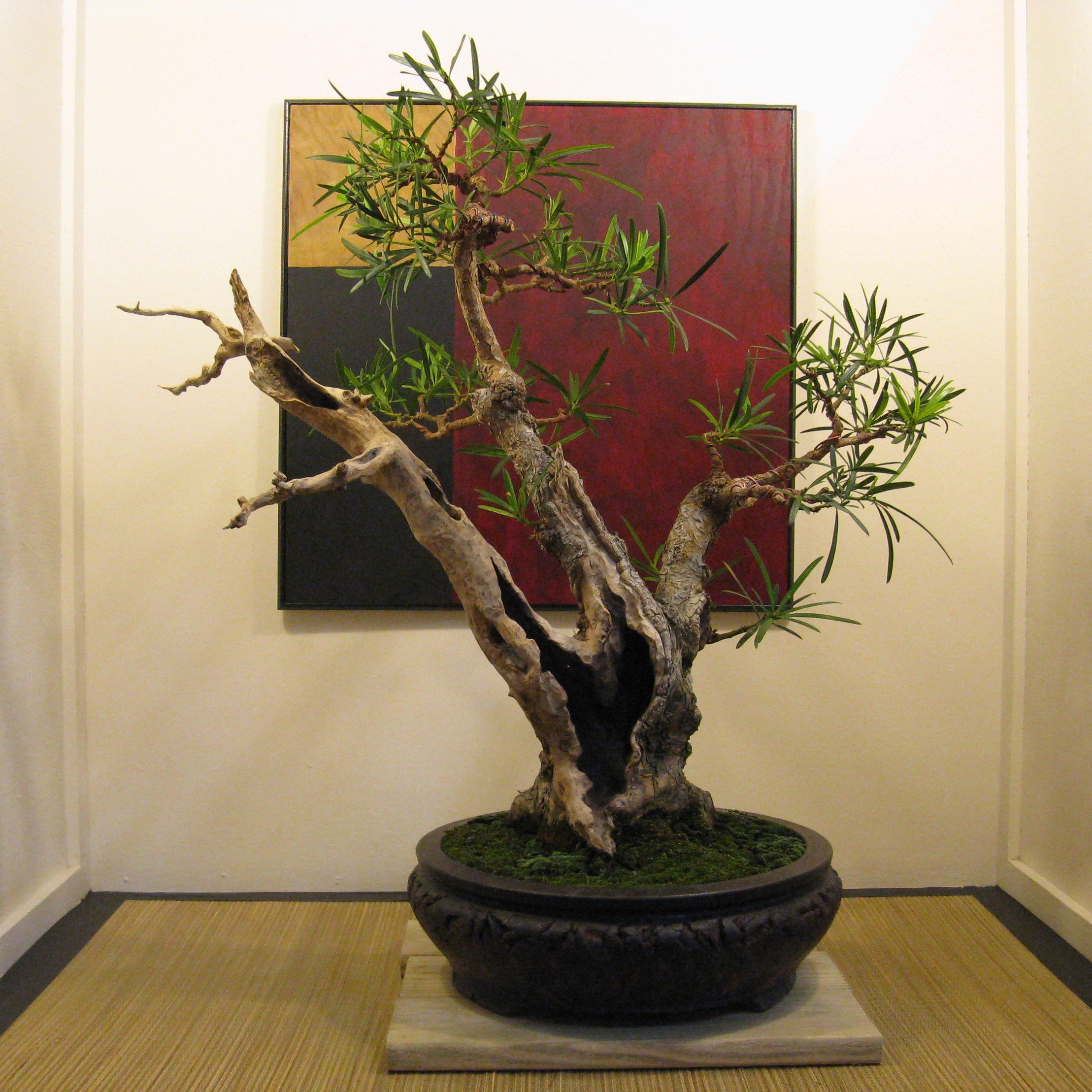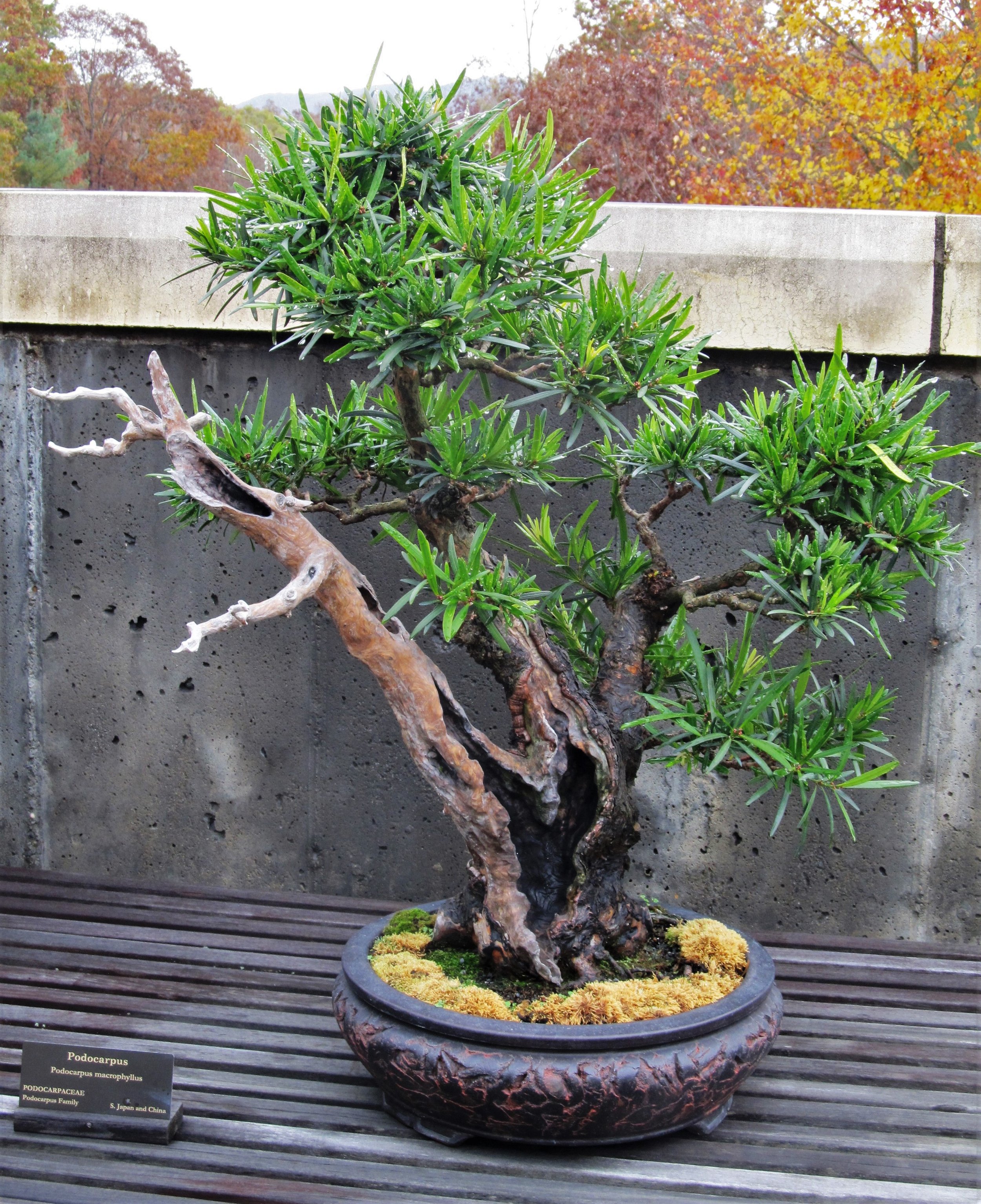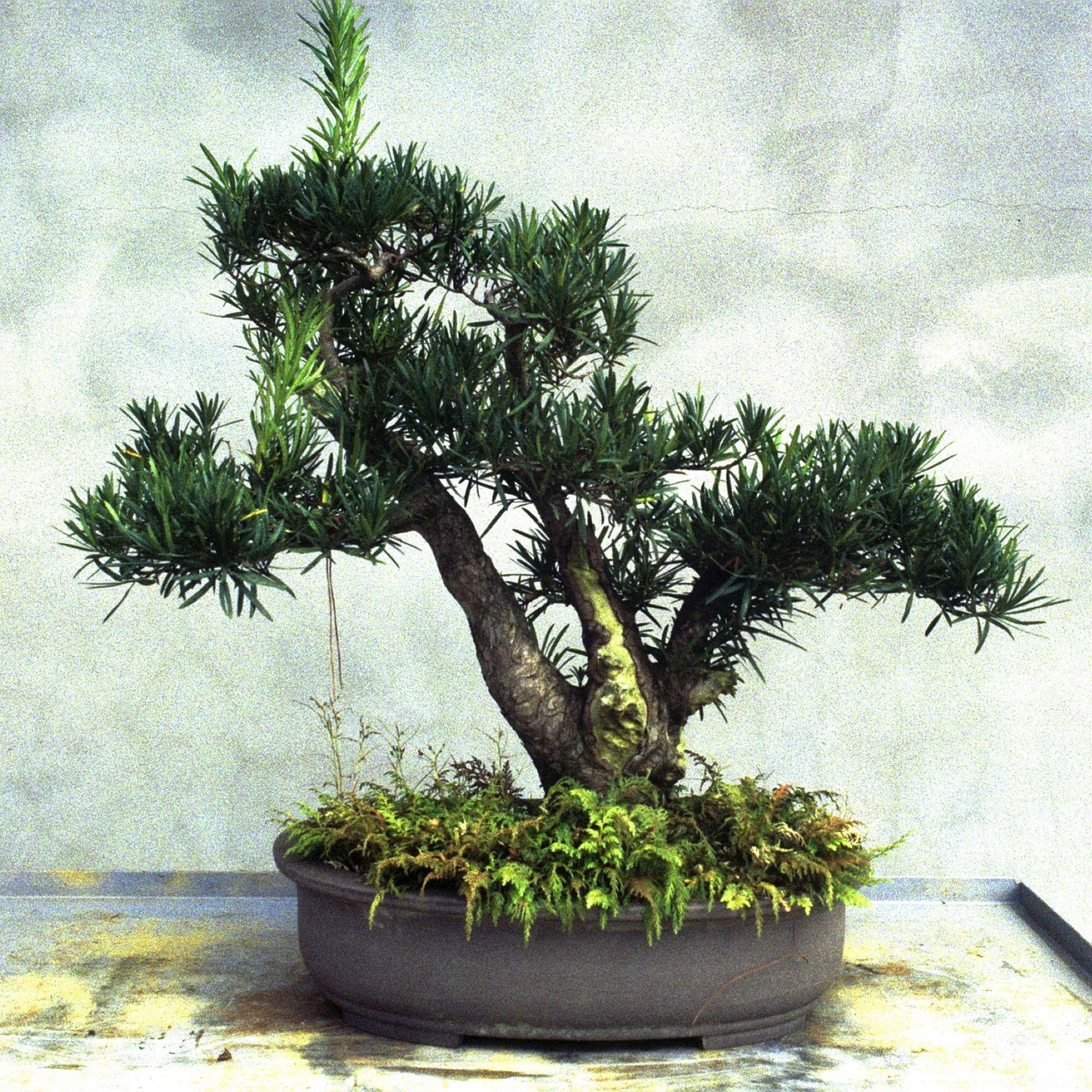Podocarpus
When you look at an old bonsai you might never guess the history of it. For example, we have in the Arboretum's bonsai collection a large podocarpus (Podocarpus macrophyllus), which we can reasonably surmise to be around seventy years old. It is the only podocarpus in the collection and should be counted among the older bonsai specimens we have. To look at it you might well recognize that it looks aged, however nothing in its appearance will give you reason to think our podocarpus grew up at a correctional facility. But it did.
In the late 1990s the Arboretum had a bonsai volunteer named Duane Clayburn. Duane moved to western North Carolina from Tallahassee, Florida, where he had operated a small bonsai nursery and been active in his local club, and in the statewide organization called the Bonsai Societies of Florida. In 1995, before he started volunteering with us, Duane showed up one day with a large podocarpus bonsai that he offered as a donation for the Arboretum's collection. The tree looked a little rough, but it was impressively large and appeared to have been around for a long time. It came with an interesting story, too.
The podocarpus at time of donation, 1995
The tale had to do with California bonsai artist Ben Oki, a teacher who traveled incessantly and swung through Florida on an annual basis. For many years Ben took the occasion of his visit to the Sunshine State to volunteer as a bonsai instructor at the Florida State Penitentiary, in a horticulture program for inmates. On one such visit it came to Ben's attention that a forty-year-old podocarpus hedge at the penitentiary was being removed, and he recognized that the individual plants making up the hedge had large, interesting trunks with lots of branching from many years of growing in the ground while being routinely sheared. At Ben's suggestion, some of those old hedge plants were gathered up and used as workshop material for his prisoner bonsai students. There were many of these unwanted podocarpus refugees available, so some found their way to other workshops conducted by Ben and one found its way into Duane Clayburn's hands. When Duane donated that same podocarpus to the Arboretum, he noted that Ben Oki had done the initial styling of the tree. In spring of 1996 the Arboretum hosted Ben as a guest artist to conduct some educational programs, and it seemed logical to offer the podocarpus to him for some rejuvenation and touch-up work on its design. When he was finished it looked much neater and more organized, but still pretty clunky. The basic construction of the tree remained the same.
Volunteer Duane Clayburn in the early 2000s
Ben Oki working on the podocarpus at the Arboretum, 1996
Here is a photo of the podocarpus from July, 2008:
In the twelve years since Ben Oki had worked on it, the bonsai was maintained in the same form as it was when we received it. I came to know the tree well and understood why its shape was bothersome to me. The three trunks of the podocarpus were all in row like soldiers. When seen from a side angle the three were perfectly lined up, and so the presentation of the tree was rather flat however you looked at it. Seen broadside, the preferred viewing angle, the three trunks fanned out in a wide spread of coarse limbs. The place where the one trunk divided and the three trunks headed off in separate directions was wider than the base of the tree, and together with the broad spreading crown combined to give the podocarpus an unstable look. And finally, there were several really large wounds on the trunks where big limbs had been removed, and these were being glacially slow in covering. I knew why the podocarpus bonsai didn't look right, but I was undecided as to how to address all the issues.
In 2008 the Carolina Bonsai Expo featured guest artist Peter Adams:
Peter Adams leading a critique of the 2008 Carolina Bonsai Expo
Peter was a figure of importance in western bonsai for four decades, starting out in the early 1970s in his native England and continuing when he relocated to the United States in the 1990s. He was the author of numerous popular bonsai books and was respected as a creative artist in multiple mediums. He had a post-graduate degree in painting from the Royal Academy Schools in London and worked at various times in portraiture, cartooning, advertising, television and teaching. Peter had been the Expo guest artist in 1997 and done a commendable job, so when he returned for an encore in 2008 I decided to give him the podocarpus to work on in a redesign demonstration. I had been uncertain what to do with the tree but trusted in Peter's skill and experience to arrive at a creative solution. Prior to the demonstration Peter produced three drawings of the podocarpus, each illustrating a different possible redesign idea. He showed me the pictures and gave me the choice of which way he should take the tree. I choose the most dramatic option and that's what Peter did in his demonstration.
Regrettably, I was too busy to photo document the program myself and the only images of it I could later secure were of pitifully low resolution. All the same, the following three photos show Peter Adams working on the big podocarpus at the 2008 Carolina Bonsai Expo:
In the first image you can see him holding up the drawing he made of what he envisioned as the outcome of his redesign. The work involved a fair amount of carving done with a die-grinder, which is shown in the second photograph. Peter had insisted on setting himself up in the very middle of the room with the audience sitting close up all around him, and I half think he wanted that so he could shower everybody in the first few rows with the chips and sawdust from his carving work. Fortunately no one from OSHA was in the audience. Also note in that second image the gigantic, almost perfectly round scar on the back side of the Podocarpus. The third image shows him doing some wiring, which, because he was a seasoned pro who knew how to hold an audience, he kept to a minimum.
Here is a photograph of the podocarpus made a month after the redesign:
There is a finite amount of time in a demonstration program, and only so much can be done (or should be done). Peter had taken the big step and set the podocarpus on an alternative course, but there was a long way to go to make the tree presentable in its new design. I felt comfortable taking up the work where Peter left off because I saw clearly now the path set out before this specimen. Here is the tree after an intensive follow-up session in early 2010:
As can be seen in the above image, the branching and foliage had been further thinned out and organized. The length of the dead trunk had been shortened so as to make it subordinate to the living trunk in the middle of the composition. The dead wood had been extensively carved, including hollowing out the one dead trunk-line and opening a large cavity in the lowest section of the tree. And to go with its new look the podocarpus was planted in a new container. The pot is one of the very few pieces of Japanese stoneware featured in our bonsai collection, but it is an atypical Japanese pot. It has a pattern of deep fissures on its surface that echo the hollowed-out look of the tree's trunk, giving the dark container an unusually strong personality.
By March the next year I felt good enough about the tree's development to put it in the Southern Spring Show in Charlotte, North Carolina:
As evidenced by the following gallery of images, the podocarpus has maintained a steadfast presence in the bonsai garden in the years since its dramatic redesign (click on any image for full view):
Podocarpus is a borderline-hardy species in this part of the world, so we treat it as a tropical plant to be on the safe side. While the temperate plants are removed from the garden and put into storage when the weather goes cold, our podocarpus is often found in the Baker Exhibit Center greenhouse in wintertime, as part of our tropical bonsai display:
In 2013 Peter Adams was slated to be guest artist once again at the Carolina Bonsai Expo. It would have been an unprecedented third time for him in that role, and to celebrate his return I selected the podocarpus to be the Expo logo tree:
I was a little anxious to find out what Peter thought of the work done on this specimen in the five years since he last saw it, but I never had a chance to get his review. Just a month before his scheduled visit with us Peter suffered a serious health issue and he passed away not long after that. The podocarpus is an enduring reminder of Peter, as well as a testament to his artistic vision.
This year the big, old podocarpus had been on hiatus since coming off winter display back in early May. It was sitting out in the hoop house, growing in unrestrained abandon and enjoying the health benefits of being allowed to do that, but it got to looking a little rangy:
The time had come for a good trim and some cleaning up. Here are the results, accomplished just earlier this week:
In addition to the comprehensive pruning, the dead wood was further refined. The large cavity at the base of the tree was carved out some more and then a mini torch was used to burn the wood inside the cavity. Charring the wood in this fashion helps protect it against rot and insect damage, but also gives the hollow a suitably dark appearance. The rest of the dead wood was treated with lime sulfur, a chemical that also protects against rot and insect damage while giving the wood a bleached look. Freshly done as it currently is, the side-by-side effect of these two treatments is stark. I do not mind the look because it heightens the drama of the dead wood feature, which is a big part of this tree's appeal. Over time the whiteness of the lime sulfured wood will become more grayish, even as the blackness of the charred wood begins to fade, and the overall contrast will become more moderate.
Cavity at base of tree, before
Cavity at base of tree, after
The gallery below shows a twenty-eight-year progression in four images (click on any image for full view):


